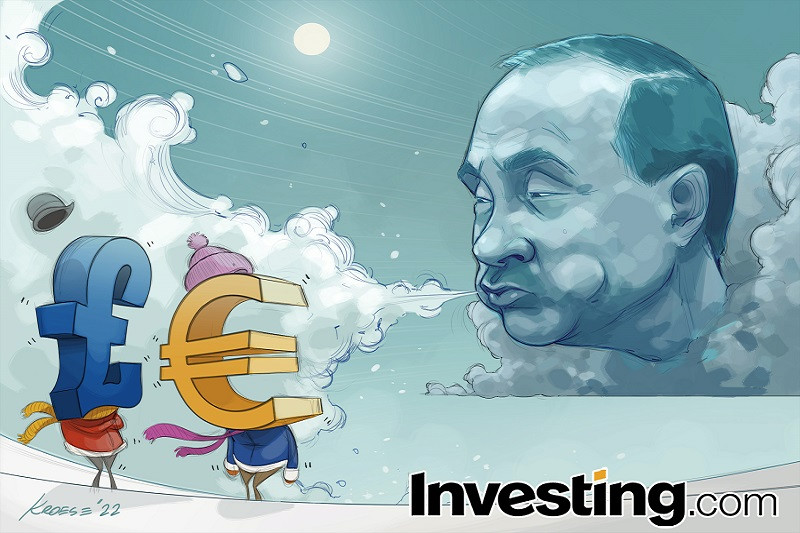Weekly Comic: A Chill Blast from the East for the Euro and Sterling
2022.08.30 21:53

© Investing.com
By Geoffrey Smith
Investing.com — How low can the euro and pound go?
Both currencies have hit multi-year lows in the last few weeks, and for good reason. The explosive rise in prices for crude oil and natural gas prices has dramatically altered the terms of trade for both the Eurozone and the U.K., which are big net importers of both.
Across Europe, companies that need energy have had to sell more pounds and euros to get their hands on the same (or even smaller) amounts of the industrialized world’s most vital commodities. Speculators who don’t have the same economic imperative but who expect the current conditions to last for a long time are adding to the strength of the moves.
The effects of that on the current account have been startling: Before this year, the U.K.’s record quarterly external deficit had been just over 32 billion pounds, in the first quarter of 2019; but in the first quarter of this year, it reached over 44.2 billion pounds (excluding trade in precious metals), a whopping 7.1% of GDP.
The Eurozone went into the crisis with a large external surplus (the region has depended on exports to sustain growth over the last decade). Last year’s surplus of 2.5% of GDP wasn’t as big as some previous ones, but still gave a large hint that domestic demand wasn’t strong enough to sustain the euro at its old levels. In the second quarter, as the price of gas and oil imports exploded in the wake of Russia’s invasion of Ukraine, the Eurozone posted three straight monthly deficits, something that hadn’t happened in over 10 years.
The Economist’s Christian Odendahl estimates that while Germany used to pay less than 1% of GDP for its gas imports, it will spend over 8% next year if wholesale prices remain where they are.
And all this has happened at a time when the U.S. Federal Reserve has been making the dollar more expensive by raising interest rates, making nominal returns on the dollar more attractive than those on the euro. A two-year risk-free investment in dollars now yields 3.47%, over 0.5% more than the sterling equivalent and a whopping 2.25% more than a two-year German government note, traditionally the Eurozone’s risk-free proxy.
Those nominal rates compare pitifully with current inflation rates of nearly 9% in the Eurozone and over 10% in the U.K. They will compare even worse if – as seems plausible – gas prices continue to rise over the winter as Russia shuts off its taps completely. Goldman Sachs (NYSE:GS) analysts said in a note at the weekend that U.K. inflation could peak at over 20% in that scenario, while the Eurozone would also suffer a later and a higher peak.
Small wonder, then, that the euro has sunk to its lowest level in 20 years, while the pound – excluding a momentary wobble at the start of the pandemic – is now at its lowest since 1985. The forward curves for both currencies suggest that, even assuming inflation comes down over the next two years, neither the European Central Bank nor the Bank of England will raise interest rates to a level that compensates for it. Real, i.e. inflation-adjusted rates, will continue to be negative, as they have been almost ever since the Great Recession 13 years ago.
As such, it is clear that financial markets do not trust either central bank to defend the purchasing power of their currencies. Which makes 10-year bond yields of 1.5% in Germany and 2.7% in the U.K. all the more surprising. One could be forgiven for thinking that markets are playing along with government hopes of getting away with a “surprise inflation” that will magic away a large part of legacy debts without leaving investors demanding a bigger premium to insure themselves against that trick being repeated.
A decade of relatively successful financial repression may have emboldened governments and central banks in that hope, allowing them to avoid wholesale economic upheaval (and mass impoverishment) by keeping the monetary spigots open.
But repression has only worked because inflation has behaved in the meantime. That is not the case any longer. Essential workers from ports to hospitals, airports and courts, are not going to take a permanent 20% reduction in real incomes sitting down.
The last time inflation was sustained for any length of time at this level, the U.K. ended up begging to the International Monetary Fund for a bailout (the current account deficit that year was less than 4%, for comparison). By the same token, the last time Germany experienced sustained inflation within a fixed exchange-rate mechanism (Bretton Woods), it chose defeating inflation over the exchange-rate peg.
This is not to say that a repeat of either of those incidents is inevitable, or even probable. Globalization and the abolition of capital controls mean that Britain can finance bigger current account deficits for longer, and the Germans of 2022 are far less prone to seek purely national solutions to their problems than their 1971 counterparts.
Even so, the tail risks of a sustained burst of double-digit inflation in Europe seem larger than markets are willing to countenance. Neither the pound nor the euro – still less their respective bond markets – appear to have much downside protection. The summer lull that allowed such complacency is about to end, with the election of a new Conservative Party leader in the U.K. and national elections in Italy, the Eurozone’s Achilles heel. After a summer of heatwaves, September looks quite capable of producing a political one.








